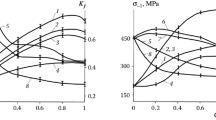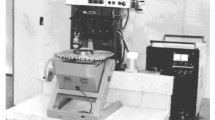Abstract
As a rule the quality of parts made of powder materials is evaluated by the criteria of structural strength, which very often do not reflect their actual operating capacity. This is connected not only with the scale factor, because specimens of rather large size are required for correct determination of crack resistance, but also with the special features of porous steels with a nonuniform concentration. The present paper concerns results of a study of the fatigue and wear resistances of metastable steel-copper pseudoalloys that are copper-infiltrated powder steels.
Similar content being viewed by others
References
K.-H. Lindner and S. M. Sonsino, “Influence of sintering time and temperature on the fatigue behavior of the diffusion alloyed PM steels Fe−4% Ni−1.5% Cu−0.5% Mo−0.6% C,”Powder Mater.,2, 819–822 (1994).
B. Lindquist, “Influence of microstructure and porosity on fatigue properties of sintered steels,”Met. Power Rep.,44(6), 744–755 (1989).
U. Engstrom and M. Gunnemyr, “Fatigue properties of sintered steels,”Powder Mater.,2, 811–814 (1994).
R. I. Sarbash, “Fatigue strength of specimens of powder steel under low-cycle rigid loading,”Poroshk. Metal., No. 9, 78–83 (1988).
C. M. Sonsino, “Fatigue design for powder metallurgy,”Met. Power Rep.,45(11), 754–764 (1990).
V. T. Troshchenko and A. Ya. Krasovskii, “Strength of porous iron in repeated alternating loading,”Poroshk. Metal., No. 5, 87–92 (1965).
V. N. Antsiferov, Yu. V. Sokolkin, A. A. Chekalkin, et al., “Numerical model of the cyclic durability of a powder material,”Poroshk. Metal., Nos. 5–6, 112–118 (1994).
V. N. Antsiferov, N. N. Maslennikov, A. A. Sharov, et al., “Powder steel with a structure of metastable austenite,”Poroshk. Metal., Nos. 3–4, 42–47 (1994).
V. N. Antsiferov, S. N. Peshcherenko, and A. A. Shatsov, “Diffusion homogenizing of powder materials of the Fe−Ni−Cr−Mo system,”Izv. Vuzov, Chern. Metal., No. 9, 65–68 (1990).
V. S. Popov, N. N. Brykov, M. I. Andrushchenko, et al., “Abrasion resistance of alloys with a structure of metastable austenite as a function of their chemical composition,”Trenie Iznos,12(1), 163–169 (1991).
V. V. Dorokhov, I. V. Kiseleva, and A. A. Ryzhikov, “Abrasion resistance of high-carbon chromium-nickel steel,”Metalloved. Term. Obrab. Met., No. 2, 30–33 (1993).
L. S. Malinov, E. Ya. Kharlanova, and E. L. Malinova, “Abrasion resistance of high-carbon manganese-vanadium steels,”Metalloved. Term. Obrab. Met., No. 2, 25–27 (1993).
M. A. Filippov, V. S. Litvinov, and Yu. R. Nemirovskii,Steels with Metastable Austenite [in Russian], Metallurgiya, Moscow (1988).
G. Poltsner and F. Maisner,Fundamentals of Friction and Wear [in Russian], Mashinostroenie, Moscow (1984).
M. A. Filippov, E. S. Studenok, B. M. Éfros, et al., “Role of structural transformations in run-in layers of austenitic steels resisting abrasive wear,”Trenie Iznos,14(3), 532–538 (1993).
V. N. Antsiferov, N. N. Maslennikov, and A. A. Shatsov, “Structural strength of steel-copper pseudoalloys,”Fiz.-Khim. Mekhan. Mater., No. 6, 95–96 (1990).
V. N. Antsiferov, N. N. Maslennikov, and A. A. Shatsov,Structural Strength of Concentration-Inhomogeneous Powder Steels [in Russian], RITTs PM, Perm (1996).
I. Le May and L. M.-D. Schottky,Copper in Ferrous Metals [Russian translation], Metallurgiya, Moscow (1988).
V. M. Shatt,Powder, Metallurgy. Sintered and Composite Materials [in Russian], Metallurgiya, Moscow (1983).
V. G. Sorokin (ed.),List of Grades of Steels and Alloys [in Russian], Mashinostroenic, Moscow (1989).
O. Anderson and B. Lindquist, “Benefits of heterogeneous structures for the fatigue behavior of PM steels,”Met. Power Rep.,45(11), 765–768 (1990).
F. F. Lange, “The interaction of a crack front with a secondphase dispersion,”Philos. Mag.,22(179), 983–984 (1970).
Author information
Authors and Affiliations
Additional information
Translated from Metallovedenie i Termicheskaya Obrabotka Metallov, No. 12, pp. 15–20, December, 1997.
Rights and permissions
About this article
Cite this article
Antsiferov, V.N., Shatsov, A.A. & Smyshlyaeva, T.V. Wear and fatigue resistances of metastable steel-copper pseudoalloys. Met Sci Heat Treat 39, 516–522 (1997). https://doi.org/10.1007/BF02471370
Issue Date:
DOI: https://doi.org/10.1007/BF02471370




